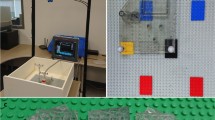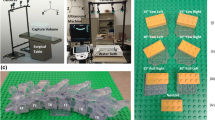Abstract
Purpose
Determine the positional, rotational and reconstruction accuracy of a 3D ultrasound system to be used for image registration in navigation surgery.
Methods
A custom 3D ultrasound for spinal surgery image registration was developed using Optitrack Prime 13-W motion capture cameras and a SonixTablet Ultrasound System. Temporal and spatial calibration was completed to account for time latencies between the two systems and to ensure accurate motion tracking of the ultrasound transducer. A mock operating room capture volume with a pegboard grid was set up to allow phantoms to be placed at a variety of predetermined positions to validate accuracy measurements. Five custom-designed ultrasound phantoms were 3D printed to allow for a range of linear and angular dimensions to be measured when placed on the pegboard.
Results
Temporal and spatial calibration was completed with measurement repeatabilities of 0.2 mm and 0.5° after calibration. The mean positional accuracy was within 0.4 mm, with all values within 0.5 mm within the critical surgical regions and 96% of values within 1 mm within the full capture volume. All orientation values were within 1.5°. Reconstruction accuracy was within 0.6 mm and 0.9° for geometrically shaped phantoms and 0.5 and 1.9° for vertebrae-mimicking phantoms.
Conclusions
The accuracy of the developed 3D ultrasound system meets the 1 mm and 5° requirements of spinal surgery from this study. Further repeatability studies and evaluation on vertebrae are needed to validate the system for surgical use.
















Similar content being viewed by others
Abbreviations
- 3D:
-
Three-dimensional
- AIS:
-
Adolescent idiopathic scoliosis
References
Hattori T, Sakaura H, Iwasaki M, Nagamoto Y, Yoshikawa H, Sugamoto K (2011) In vivo three-dimensional segmental analysis of adolescent idiopathic scoliosis. Eur Spine J Off Publ Eur Spine Soc Eur Spinal Deform Soc Eur Sect Cerv Spine Res Soc 20:1745–1750
Konieczny MR, Senyurt H, Krauspe R (2013) Epidemiology of adolescent idiopathic scoliosis. J Child Orthop 7:3–9
Richards BS, Bernstein RM, D’Amato CR, Thompson GH (2005) Standardization of criteria for adolescent idiopathic scoliosis brace studies: SRS Committee on bracing and nonoperative management. Spine 30:2068–2075 (discussion 2076–2077)
Basques BA, Lukasiewicz AM, Samuel AM, Webb ML, Bohl DD, Smith BG, Grauer JN (2017) Which pediatric orthopaedic procedures have the greatest risk of adverse outcomes? J Pediatr Orthop 37:429–434. https://doi.org/10.1097/BPO.0000000000000683
Maruyama T, Takeshita K (2008) Surgical treatment of scoliosis: a review of techniques currently applied. Scoliosis 3:6. https://doi.org/10.1186/1748-7161-3-6
Cuartas E, Rasouli A, O’Brien M, Shufflebarger HL (2009) Use of all-pedicle-screw constructs in the treatment of adolescent idiopathic scoliosis. J Am Acad Orthop Surg 17:550–561
Coe JD, Arlet V, Donaldson W, Berven S, Hanson DS, Mudiyam R, Perra JH, Shaffrey CI (2006) Complications in spinal fusion for adolescent idiopathic scoliosis in the new millennium. A report of the Scoliosis Research Society Morbidity and Mortality Committee. Spine 31:345–349. https://doi.org/10.1097/01.brs.0000197188.76369.13
Kosmopoulos V, Schizas C (2007) Pedicle screw placement accuracy: a meta-analysis. Spine 32:E111–E120. https://doi.org/10.1097/01.brs.0000254048.79024.8b
Reames DL, Smith JS, Fu K-MG, Polly DW, Ames CP, Berven SH, Perra JH, Glassman SD, McCarthy RE, Knapp RD, Heary R, Shaffrey CI, Scoliosis Research Society Morbidity and Mortality Committee (2011) Complications in the surgical treatment of 19,360 cases of pediatric scoliosis: a review of the scoliosis research society morbidity and mortality database. Spine 36:1484–1491. https://doi.org/10.1097/brs.0b013e3181f3a326
Zindrick MR, Knight GW, Sartori MJ, Carnevale TJ, Patwardhan AG, Lorenz MA (2000) Pedicle morphology of the immature thoracolumbar spine. Spine 25:2726–2735
Rampersaud YR, Simon DA, Foley KT (2001) Accuracy requirements for image-guided spinal pedicle screw placement. Spine 26:352–359. https://doi.org/10.1097/00007632-200102150-0001
Chan A, Parent E, Narvacan K, San C, Lou E (2017) Intraoperative image guidance compared with free-hand methods in adolescent idiopathic scoliosis posterior spinal surgery: a systematic review on screw-related complications and breach rates. Spine J 17:1215–1229. https://doi.org/10.1016/j.spinee.2017.04.001
Puvanesarajah V, Liauw JA, Lo S, Lina IA, Witham TF (2014) Techniques and accuracy of thoracolumbar pedicle screw placement. World J Orthop 5:112–123. https://doi.org/10.5312/wjo.v5.i2.112
Takahashi J, Hirabayashi H, Hashidate H, Ogihara N, Kato H (2010) Accuracy of multilevel registration in image-guided pedicle screw insertion for adolescent idiopathic scoliosis. Spine 35:347–352. https://doi.org/10.1097/BRS.0b013e3181b77f0a
Walker CT, Turner JD (2015) Radiation exposure in scoliosis surgery: freehand technique versus image guidance. World Neurosurg 83:282–284. https://doi.org/10.1016/j.wneu.2015.01.004
Ul Haque M, Shufflebarger HL, O’Brien M, Macagno A (2006) Radiation exposure during pedicle screw placement in adolescent idiopathic scoliosis: is fluoroscopy safe? Spine 31:2516–2520. https://doi.org/10.1097/01.brs.0000238675.91612.2f
Brenner DJ (2002) Estimating cancer risks from pediatric CT: going from the qualitative to the quantitative. Pediatr Radiol 32:228–231. https://doi.org/10.1007/s00247-002-0671-1 (discussion 242–244)
Pearce MS, Salotti JA, Little MP, McHugh K, Lee C, Kim KP, Howe NL, Ronckers CM, Rajaraman P, Craft AW, Parker L, de González AB (2012) Radiation exposure from CT scans in childhood and subsequent risk of leukaemia and brain tumours: a retrospective cohort study. Lancet 380:499–505. https://doi.org/10.1016/S0140-6736(12)60815-0
Frush DP, Applegate K (2004) Computed tomography and radiation: understanding the issues. J Am Coll Radiol 1:113–119. https://doi.org/10.1016/j.jacr.2003.11.012
Nelson EM, Monazzam SM, Kim KD, Seibert JA, Klineberg EO (2014) Intraoperative fluoroscopy, portable X-ray, and CT: patient and operating room personnel radiation exposure in spinal surgery. Spine J Off J N Am Spine Soc 14:2985–2991. https://doi.org/10.1016/j.spinee.2014.06.003
Mujagić M, Ginsberg HJ, Cobbold RSC (2008) Development of a method for ultrasound-guided placement of pedicle screws. IEEE Trans Ultrason Ferroelectr Freq Control 55:1267–1276. https://doi.org/10.1109/TUFFC.2008.789
Yan CXB, Goulet B, Pelletier J, Chen SJ-S, Tampieri D, Collins DL (2011) Towards accurate, robust and practical ultrasound-CT registration of vertebrae for image-guided spine surgery. Int J Comput Assist Radiol Surg 6:523–537. https://doi.org/10.1007/s11548-010-0536-2
Yan CXB, Goulet B, Tampieri D, Collins DL (2012) Ultrasound-CT registration of vertebrae without reconstruction. Int J Comput Assist Radiol Surg 7:901–909. https://doi.org/10.1007/s11548-012-0771-9
Mercier L, Langø T, Lindseth F, Collins DL (2005) A review of calibration techniques for freehand 3-D ultrasound systems. Ultrasound Med Biol 31:449–471. https://doi.org/10.1016/j.ultrasmedbio.2004.11.015
Huang Q, Zeng Z (2017) A review on real-time 3D ultrasound imaging technology. BioMed Res Int. https://doi.org/10.1155/2017/6027029
Kindratenko VV (2000) A survey of electromagnetic position tracker calibration techniques. Virtual Real 5:169–182. https://doi.org/10.1007/BF01409422
Chan A, Aguillon J, Hill D, Lou E (2017) Precision and accuracy of consumer-grade motion tracking system for pedicle screw placement in pediatric spinal fusion surgery. Med Eng Phys 46:33–43. https://doi.org/10.1016/j.medengphy.2017.05.003
Moore TR (2011) The role of amniotic fluid assessment in evaluating fetal well-being. Clin Perinatol 38:33–46. https://doi.org/10.1016/j.clp.2010.12.005
Unsgaard G, Rygh OM, Selbekk T, Müller TB, Kolstad F, Lindseth F, Hernes TAN (2006) Intra-operative 3D ultrasound in neurosurgery. Acta Neurochir (Wien) 148:235–253. https://doi.org/10.1007/s00701-005-0688-y
Zheng R, Chan ACY, Chen W, Hill DL, Le LH, Hedden D, Moreau M, Mahood J, Southon S, Lou E (2015) Intra- and inter-rater reliability of coronal curvature measurement for adolescent idiopathic scoliosis using ultrasonic imaging method: a pilot study. Spine Deform 3:151–158. https://doi.org/10.1016/j.jspd.2014.08.008
Chen Z, Wu B, Zhai X, Bai Y, Zhu X, Luo B, Chen X, Li C, Yang M, Xu K, Liu C, Wang C, Zhao Y, Wei X, Chen K, Yang W, Ta D, Li M (2015) Basic study for ultrasound-based navigation for pedicle screw insertion using transmission and backscattered methods. PLoS ONE 10:e0122392. https://doi.org/10.1371/journal.pone.0122392
Chen TK, Abolmaesumi P, Thurston AD, Ellis RE (2006) Automated 3D freehand ultrasound calibration with real-time accuracy control. In: MICCAI international conference medical image computing and computer-assisted intervention, vol 9, pp 899–906
De Lorenzo D, Vaccarella A, Khreis G, Moennich H, Ferrigno G, De Momi E (2011) Accurate calibration method for 3D freehand ultrasound probe using virtual plane. Med Phys 38:6710–6720. https://doi.org/10.1118/1.3663674
Narouze SN (ed) (2011) Atlas of ultrasound-guided procedures in interventional pain management [electronic resource]. Springer, New York
Solberg OV, Lindseth F, Torp H, Blake RE, Nagelhus Hernes TA (2007) Freehand 3D ultrasound reconstruction algorithms: a review. Ultrasound Med Biol 33:991–1009. https://doi.org/10.1016/j.ultrasmedbio.2007.02.015
Barratt DC, Davies AH, Hughes AD, Thom SA, Humphries KN (2001) Optimisation and evaluation of an electromagnetic tracking device for high-accuracy three-dimensional ultrasound imaging of the carotid arteries. Ultrasound Med Biol 27:957–968
Treece GM, Gee AH, Prager RW, Cash CJC, Berman LH (2003) High-definition freehand 3-D ultrasound. Ultrasound Med Biol 29:529–546
Hsu P-W, Prager RW, Gee AH, Treece GM (2009) Freehand 3D ultrasound calibration: a review. In: Sensen CW, Hallgrímsson B (eds) Advanced imaging in biology and medicine. Springer, Berlin, pp 47–84
Koivukangas T, Katisko JP, Koivukangas JP (2013) Technical accuracy of optical and the electromagnetic tracking systems. SpringerPlus. https://doi.org/10.1186/2193-1801-2-90
Yang P-F, Sanno M, Brüggemann G-P, Rittweger J (2012) Evaluation of the performance of a motion capture system for small displacement recording and a discussion for its application potential in bone deformation in vivo measurements. Proc Inst Mech Eng 226:838–847
Lim JS (1990) Two-dimensional signal and image processing. Prentice-Hall Inc., Upper Saddle River
Soille P (2003) Morphological image analysis: principles and applications, 2nd edn. Springer, Berlin
Poulsen C, Pedersen PC, Szabo TL (2005) An optical registration method for 3D ultrasound freehand scanning. In: IEEE ultrasonics symposium, 2005, pp 1236–1240
Ioannou C, Sarris I, Yaqub MK, Noble JA, Javaid MK, Papageorghiou AT (2011) Surface area measurement using rendered three-dimensional ultrasound imaging: an in vitro phantom study. Ultrasound Obstet Gynecol Off J Int Soc Ultrasound Obstet Gynecol 38:445–449. https://doi.org/10.1002/uog.8984
Zenbutsu S, Igarashi T, Nakamura R, Nakaguchi T, Yamaguchi T (2013) 3D ultrasound assisted laparoscopic liver surgery by visualization of blood vessels. In: 2013 IEEE international ultrasonics symposium (IUS), pp 840–843
Penney GP, Barratt DC, Chan CSK, Slomczykowski M, Carter TJ, Edwards PJ, Hawkes DJ (2006) Cadaver validation of intensity-based ultrasound to CT registration. Med Image Anal 10:385–395. https://doi.org/10.1016/j.media.2006.01.003
Acknowledgements
This research was funded by the Alberta Spine Foundation. The first author of this research was funded by the Natural Sciences and Engineering Research Council and Alberta Innovates: Technology Futures.
Author information
Authors and Affiliations
Corresponding author
Ethics declarations
Conflict of interest
The authors have no conflicts of interest to declare.
Human and animal rights
This article does not contain any studies with human participants or animals performed by any of the authors.
Informed consent
No individual patients were included in this study.
Rights and permissions
About this article
Cite this article
Chan, A., Parent, E. & Lou, E. Reconstruction and positional accuracy of 3D ultrasound on vertebral phantoms for adolescent idiopathic scoliosis spinal surgery. Int J CARS 14, 427–439 (2019). https://doi.org/10.1007/s11548-018-1894-4
Received:
Accepted:
Published:
Issue Date:
DOI: https://doi.org/10.1007/s11548-018-1894-4




